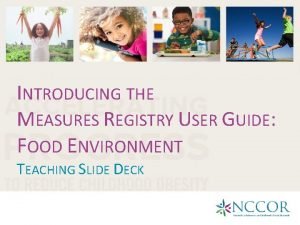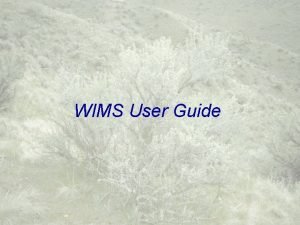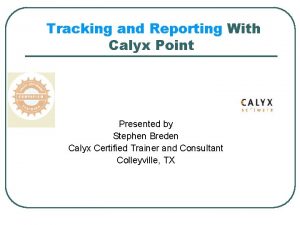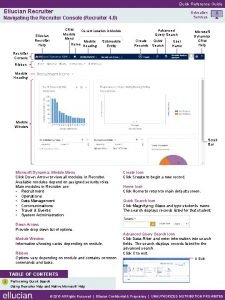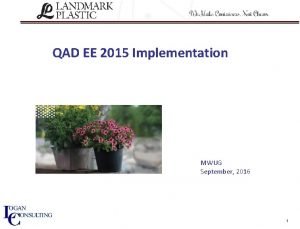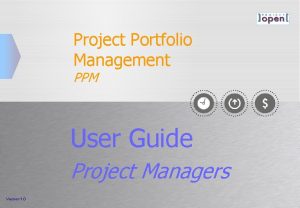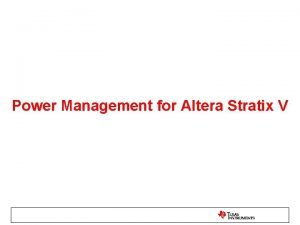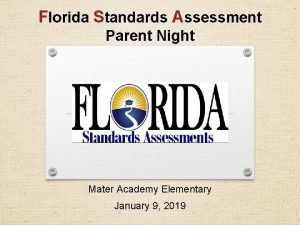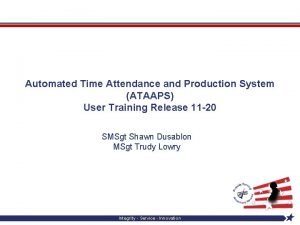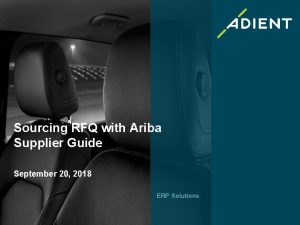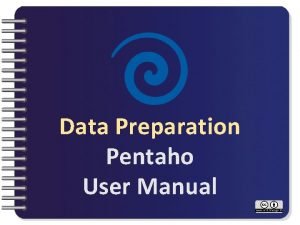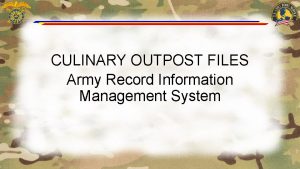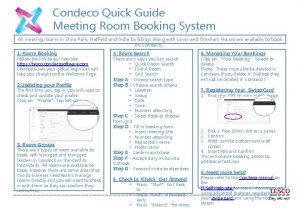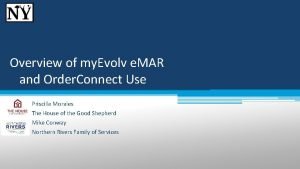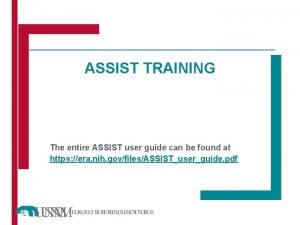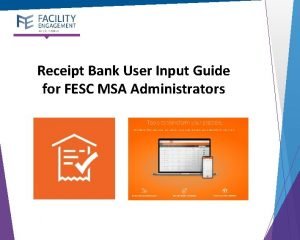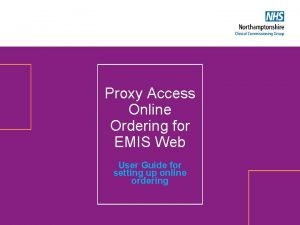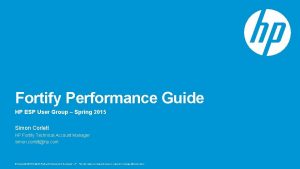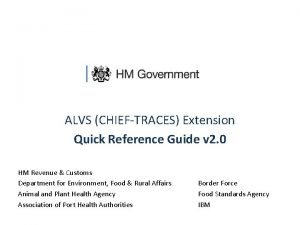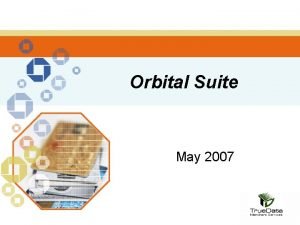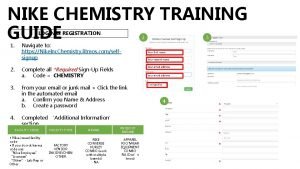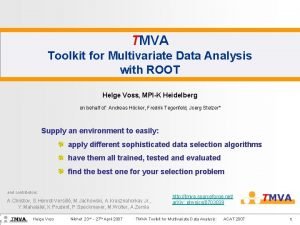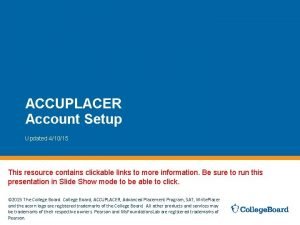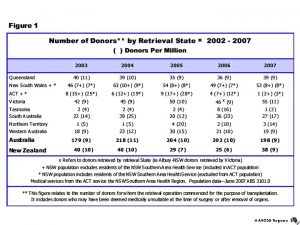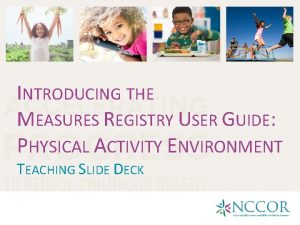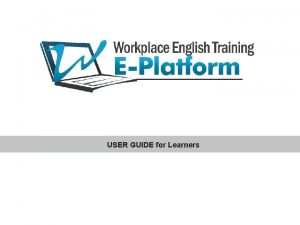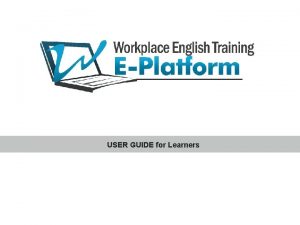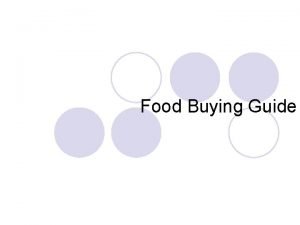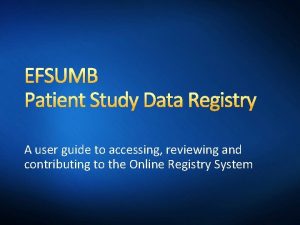INTRODUCING THE MEASURES REGISTRY USER GUIDE FOOD ENVIRONMENT






































































- Slides: 70

INTRODUCING THE MEASURES REGISTRY USER GUIDE: FOOD ENVIRONMENT TEACHING SLIDE DECK

Measures Registry User Guides • The User Guides are designed to: § Provide an overview of measurement § Describe general principles of measurement selection § Present case studies that walk users through the process of using the Measures Registry to select appropriate measures § Direct researchers and practitioners to additional resources and sources of useful information • The User Guides cover the four domains for the Measures Registry: § § Individual Diet Food Environment Individual Physical Activity Environment • The User Guides aim to help move the field forward by fostering more consistent use of measures, which will allow for standardization, metaanalyses, and synthesis. 2

In this Presentation 1. Introduction to NCCOR and the Measures Registry 2. Measuring Food Environment 3. Measurement Characteristics 4. Measurement in Action 3

Introduction to NCCOR and the Measures Registry

NCCOR Mission and Goals • The mission of NCCOR is to accelerate progress in reducing childhood obesity. • NCCOR is focused on: § Collaborating to turn the tide on childhood obesity § Supporting researchers with tools that help build the capacity for research and surveillance § Maximizing outcomes from research and supporting evaluations § Using innovation to stimulate broad thinking to generate fresh, synergistic ideas § Increasing knowledge to find solutions by promoting new research funding mechanisms and translating and disseminating research findings § Looking to the road ahead and building new partnerships to solve problems 5

Collaboration • Building on each other’s strengths, CDC, NIH, RWJF, and USDA formed a unique public private partnership – NCCOR 6

Strategic Alliance • In 2015, NCCOR formed a strategic partnership with The JPB Foundation to develop User Guides to strengthen the Measures Registry, a landmark tool to help researchers find and select measures for childhood obesity research 7

Measures Registry http: //www. nccor. org/nccor-tools/measures/ 8

Measuring Food Environment

Why Study the Food Environment? • Influences health-related outcomes: § Weight status/obesity § Dietary patterns § Chronic disease • Target of public health interventions • Robust measures are needed for epidemiologic and intervention studies 10

Conceptual Model of Environmental Factors Related to Dietary Disease Risk PHYSICAL ENVIRONMENT PERSON-CENTERED ENVIRONMENT Food Choices Dietary Consumption Dietary-related Disease Risk SOCIAL ENVIRONMENT 11

1. Physical PHYSICAL ENVIRONMENT • Home • Childcare, preschool, and community venues • Stores and restaurants 1. How many and what types of food venues are present? 2. What foods are available? 3. What foods are accessible? 4. What health-related information is present? 12

2. Social SOCIAL ENVIRONMENT Social referents: • Other Youth • Parents • Teachers • Other adults 1. Support for healthy food choices 2. Role modeling or social expectation of food choice, eating behavior 3. Food choice incentives or rewards 4. Policies, practices, or rules about eating behavior 13

3. Person-Centered PERSON-CENTERED ENVIRONMENT 1. Perceptions of the physical environment • Availability, access • Affordability • Acceptability of product 2. Perceptions of the social environment • Social norms • Social support • Perceptions of policies, rules • Perceptions of cultural appropriateness 14

Measuring Food Environment PHYSICAL ENVIRONMENT SOCIAL ENVIRONMENT PERSON-CENTERED ENVIRONMENT 15

1. Physical PHYSICAL ENVIRONMENT • Geo-spatial analyses or GIS § Number, location, density of food stores or restaurants § Proximity of food stores or restaurants to home, schools or community venues, and each other • Observational scans or assessments § AKA “log, ” “record, ” “audit, ” “environmental scan” § Product availability § Pricing § Placement/merchandising § Advertising and information • Measures Registry: GIS; environmental observation; record or log 16

17

Audit Tools, Environmental Scans 18

2. Social SOCIAL ENVIRONMENT • Interviews or questionnaires with parents and children • Self-administered/self-report questionnaire • Questionnaires of stakeholders/policy decision makers (e. g. , food service staff or school principal) • Measures Registry: questionnaires; records or logs 19

CDC: School Health Policy and Practice Survey https: //www. cdc. gov/healthyyouth/data/shpps/questionnaires. htm 20

3. Person-Centered • • PERSON-CENTERED ENVIRONMENT Phone interview Self-administered questionnaire Questionnaire read to children Measures Registry: questionnaire, record or log 21

CATCH: Health Behavior Questionnaire 22

Measurement Characteristics

Using the Measures Registry: How Does the Conceptual Model Help? • What domain or domains do I need to study? • Is my purpose to examine predictors of food choice in a population or to examine one aspect of the environment already linked to a health outcome? • If I’m interested in studying the physical environment, what venues to I want to assess? • If I’m interested in studying the social environment, what aspects and referents should I focus on? • Is it important to assess people’s perceptions of their environment? • Is my question etiologic or am I testing an intervention? 24

Two Critical Features of Measures: Important in Environmental Measures as Well! RELIABILITY VALIDITY • Do two independent observers record data on the environment in a similar way? (inter-rater) • Does the measure used seem to assess the factor of interest? (face validity) • Is the measure used related to a gold standard measure of the environment? (criterion) • Do the items used to assess the environment include all of the relevant aspects of the environment? (content) • Is the environmental measure related to other factors in expected directions? (construct) • Is there consistency over time in how the environment is assessed? (test-retest) • Are items designed to measure the same aspect of the environment correlated? (internal consistency) 25

Measurement in Action

List of Included Case Studies • Case Study 1: Study to Evaluate a School-based Intervention on its Ability to Positively Influence the School Food Environment • Case Study 2: Study to Evaluate a Family-based Intervention on Its Ability to Reduce BMI-z Scores in Obese Children • Case Study 3: Intervention to Improve Healthy Eating Behaviors in Independent Neighborhood Restaurants • Case Study 4: Study on Implementing a Farmers Marketbased Obesity Treatment Program to Change Purchase and Eating Behaviors for Women and Children Enrolled in WIC/SNAP 27

Case Study 1: Study to Evaluate a School-based Intervention on Its Ability to Positively Influence the School Food Environment 28

Case Study 1: Background SCHOOL • Children spend > 1, 200 hours in school each year • School’s physical food environment influences availability and choice • School provides a strong social environment for role modeling and setting expectations regarding eating • Early learning at school influences attitudes and beliefs around food and health 29

Case Study 1: Background SCHOOL • School food environment includes: § Foods available in the cafeteria as part of federally reimbursed meals § Competitive foods available throughout the school including vending and à la carte in the cafeteria, other locations § Role modeling of eating behaviors from peers and other adults § Policies and practices regarding food used as incentives and reinforcements 30

Case Study 1: Background SCHOOL • Project = improving à la carte food healthfulness with a focus on: § Calories § Added sugars • 24 schools in a metropolitan area • Intervention partners with § School food service staff to increase the availability of healthy foods on the line (the physical environment) § Students to increase willingness to purchase healthier options (social and person-centered environments) 31

Case Study 1: Background SCHOOL • Group-randomized, pre-post design • Primary outcome: Change in foods sold in the à la carte line § Primary hypothesis: There will be an increase in the proportion of healthier foods and beverages sold on the à la carte line • Secondary outcome: Change in the foods available to students § Secondary hypothesis: There will be more healthy items available to students on the à la carte line 32

Case Study 1: Considerations SCHOOL • How will they document what is sold on the à la carte lines before and after the intervention? • How will they document what is available on the à la carte lines before and after the intervention? • How often and when will data collection occur? • What resources are available for data collection, cleaning, and analysis? 33

Case Study 1: Considerations SCHOOL • Will they collect sales data directly, or will they need to interview or observe students as they purchase food? • What is the relationship with the school staff? Are they happy collaborators or have little say or interest in the change to à la carte? • How much detail on the foods available and sold is necessary to evaluate the success of their intervention? 34

Case Study 1: Measures Selection SCHOOL Decisions: • Items on à la carte change quickly, so multiple data collection days need to be scheduled for both the pre and post phases of data collection • They can use direct sales data from cash registers to collect data on sales • Study staff will need to collect the data on foods available on the line, but resources are limited 35

Case Study 1: Measures Selection SCHOOL • Select the “Food Environment” domain, enter “School” as measure type, find >100 matches • One study (TACOs) was found that used sales data from cash register information to collect data on sales. • TACOs also had a food inventory measure, but the protocol was deemed to be too labor intensive and beyond the study’s resources. 36

Case Study 1: Measures Selection SCHOOL • One study (IDEA/ECHO) was found that used an inventory approach with information on à la carte items collected by study staff • À la carte items classified as more or less healthful using a set criteria • Criterion validity of the scale had been established • The inventory form could be used, or slightly adapted, to meet their study needs and budget 37

Case Study 1: Summary Table Title: Study to Evaluate a School-based Intervention on Its Ability to Positively Influence the School Food Environment Type of Case Study • Intervention Background • School-based obesity prevention intervention to change à la carte offerings in 24 metro area middle school cafeterias • Primary outcome is foods sold on à la carte using sales data from cash register receipts • Secondary outcome is foods available on à la carte Considerations • Schools are willing/able to provide daily detailed sales data • Study staff will need to assess food and beverage availability • Measures Registry > Food Environment > Schools Measure Selection • TACOs for primary outcome • IDEA/ECHO checklist for documentation of available food 38

Case Study 2: Study to Evaluate a Family-based Intervention on Its Ability to Reduce BMI-z Scores in Obese Children 39

Case Study 2: Background FAMILY • Youth obesity risk related to family and home environment • Eating, activity, and sedentary behaviors all influenced by home/family physical and social environments • Home/family either protects or creates risk • Obesity treatment must include home/family 40

Case Study 2: Background FAMILY • Home-based factors for obesity risk: § Physical – foods and beverages, amount of media and physical activity equipment available § Social – parental role modeling of eating, activity, and sedentary behavior; parental parenting practices around weight-related behavior § Person-centered – youth assimilate attitudes, beliefs, and values around health and health behaviors from their families 41

Case Study 2: Background FAMILY • Project = evaluate a family-based intervention to reduce obesity risk in obese 8 - to 10 -year-olds • 100 families recruited from area clinics • Randomized controlled trial • Intervention = § Foods available in the home (physical environment) § Foster positive parenting practices (social environment) § Foster positive attitudes around child eating behavior (person-centered) 42

Case Study 2: Background FAMILY • Primary outcome: Body mass index (BMI) § Primary hypothesis: BMI trajectory of those exposed to the intervention will show slower gain as compared to students in the control condition • Secondary outcomes: Foods available in the home; parenting practices and attitudes around children’s eating behaviors § Secondary hypotheses: The intervention will result in healthier foods in the home, greater use of positive parenting practices, and more positive parental attitudes around their child’s eating behavior 43

Case Study 2: Considerations FAMILY • The team has experience in measuring BMI and assessing change in the child’s diet, but they are looking for ways to assess: § Foods available in the home § Parenting practices § Parental attitudes about their child’s eating behaviors 44

Case Study 2: Considerations FAMILY • What specific aspects of the home food environment will the intervention target? • Will the intervention target a wide range of foods available or just a few types of foods? • Is there a valid and reliable instrument available? • Are there a valid and reliable tools for assessing parenting practices and parents’ attitudes related to obesity? 45

Case Study 2: Considerations FAMILY • How do we minimize response burden and response bias? • How many times do we need to assess the home food environment? • How much do foods in the home change day-by-day? 46

Case Study 2: Measures Selection FAMILY • Select “Food Environment” and enter “Home food inventory” as a search option • Decides: Assess the larger home food environment, not just specific foods • Eliminate measures that are not appropriate § Age (i. e. , preschool age children) § Population characteristics (WIC participants) 47

Case Study 2: Measures Selection FAMILY • Home Food Inventory found that: § Assesses a wide variety of foods § Can be completed by parents in a short amount of time § Can be used to construct an obesogenic food index from the data § Has good reliability and validity, including construct validity between obesogenic score and energy intake of parents and youth 48

Case Study 2: Measures Selection FAMILY • Choose Child Feed Questionnaire (CFQ) because: § It included seven scales related to child eating behavior and the family-food environment including parenting practices related to parents pressuring their child to eat, parental monitoring of child behavior, and parents’ concern about their child’s eating § It had been tested in three different, diverse samples of parents and found to be valid and reliable § Construct validity showed a significant relationship between scores on the CFQ and child weight status 49

Case Study 2: Summary Table Title: Study to Evaluate a Family-based Intervention on Its Ability to Reduce BMI-z Scores in Obese Children Type of Case Study • Intervention Background • Evaluating effectiveness of family-based obesity treatment intervention for children ages 8– 10 (RCT; n=100 families) • Need to characterize obesogenic nature of the homes and change in-home and family social environment related to the intervention Considerations • Need to assess foods available in the home • Need to assess parenting practices and attitudes related to children’s eating behavior • Measures Registry > Food Environment > Home Food Inventory Measure Selection • • Home Food Inventory Child Feeding Questionnaire 50

Case Study 3: Intervention to Improve Healthy Eating Behaviors in Independent Neighborhood Restaurants 51

Case Study 3: Background NEIGHBORHOOD • Neighborhood environment includes foods available in restaurants, pricing and promotion of those foods • Small, independent restaurants may be open to working with community change agents to provide healthier options at competitive prices 52

Case Study 3: Background NEIGHBORHOOD • Large city health department is working with the local restaurant association to improve residents’ access to healthy foods in locally owned and independently operated restaurants (physical environment) • 2 -year project § Baseline data collection § Follow-up data collection at 2 years • Project goal: Identify change in availability and pricing and changes in menu sales over 2 years 53

Case Study 3: Considerations NEIGHBORHOOD • Recruit independent restaurant owners • Training health department and restaurant association staff to collect data on: § Menus in each restaurant (including types of foods offered, serving size, and price per serving) § Contextual factors that may influence patrons’ decision making about menu selection (such as menu labeling or nutrition information) § Sales records from before and after the program begins 54

Case Study 3: Measures Selection NEIGHBORHOOD • Select the “Food environment” domain, the “Environmental Observation” measure type and the “Metro/Urban” context • Nearly 100 matches show up § Eight matches look like they are relevant to the project and meet the resource scope 55

Case Study 3: Measures Selection NEIGHBORHOOD • The team leader clicks on “Compare” for the eight most relevant measures that emerged from the original search • All eight measures report on the validity and reliability of their tool • Only four of the candidates make the complete measurement tool available on the Measures Registry 56

Case Study 3: Measures Selection NEIGHBORHOOD • Of the four measures that include the complete tool on the Measures Registry, the NEMS-R tool has some advantages including: § Has been widely used § Offers free training in how to use and analyze the data § Has demonstrated reliability 57

Case Study 3: Measures Selection NEIGHBORHOOD • Choose NEMS-R – but it has limited evidence of construct validity • Team designs ways to evaluate the construct validity as part of the pilot testing of the tool • Examine relationships between constructs: § Prices of healthier entrees versus less healthful entrees § Sales of healthier entrees versus less healthful entrees 58

Case Study 3: Summary Table Title: Intervention to Improve Healthy Eating Behaviors in Independent Neighborhood Restaurants Type of Case Study • Program evaluation Background • Large city health department with goal to prevent obesity and chronic disease and promote economic development • Collect baseline and follow-up data on foods and prices in locally owned and operated restaurants Considerations • Data collectors are health department and restaurant association staff • Measures Registry > Food Environment > Environmental Observation > Metro/Urban > Compare Measure Selection • NEMS-R: Instrument is freely available, has been widely used, includes a free online training, and has demonstrated reliability 59

Case Study 4: Study on Implementing A Farmers Market-based Obesity Treatment Program to Change Purchase and Eating Behaviors for Women and Children Enrolled in WIC/SNAP 60

Case Study 4: Background FARMERS MARKETS • Program initiated by a state department of health and human services • Community-based program • Change purchasing and eating behaviors for women and children receiving WIC or SNAP benefits • Goal: § Improve overall dietary intake § Reduce obesity risk 61

Case Study 4: Background FARMERS MARKETS • Program involves nutrition educators employed through WIC/SNAP • Evaluating progress over 1 year • Intervention components: § Group classes on preparing fruit and vegetable dishes with an emphasis on canned and frozen foods § Marketing and promotion of fruits and vegetables in WIC/SNAP stores and farmers markets § Home visits to provide skill building § Quarterly check-ins with nutritionists 62

Case Study 4: Considerations FARMERS MARKETS • Nutritionists will collect BMI data at home visits and conduct surveys with parents to assess changes in attitudes, skills, and eating behavior • The team is looking for ways to assess foods, particularly fruits and vegetables, available in the home 63

Case Study 4: Measures Selection FARMERS MARKETS • Select “Food Environment, ” “Environmental observation” measure type, add “home” to the search box • More than a dozen measures are found • The team leader scans the list to look for the options that appear most relevant 64

Case Study 4: Measures Selection FARMERS MARKETS • Many of the potential options are easily eliminated since they don’t fit the population or the focus of this study • One measure, Exhaustive Home Food Inventory for WIC Participant Households, looks promising 65

Case Study 4: Measures Selection FARMERS MARKETS Advantages of the measure: • Scanned Universal Product Codes to input objective data on all canned and frozen fruit and vegetable products found in the home • Quickly administered in the home by data collectors who do not need extensive training • Data linked to a reference database providing excellent profiles of all foods found in the home 66

Case Study 4: Measures Selection FARMERS MARKETS Disadvantages: • Reliability and validity data are limited § Must build that in to the project • Collects processed fruit and vegetable data only, not fresh § Consider adding items § Collect purchase occasion data to know how long frozen/canned items have been in the home 67

Case Study 4: Summary Table Title: Study on Implementing a Farmers Market-based Obesity Treatment Program to Change Purchase and Eating Behaviors for Women and Children Enrolled in WIC/SNAP Type of Case Study • Program evaluation Background • State health department and Farmers Market Coalition partnership to change purchase and eating behaviors • Outcomes are parent BMI, child BMI, changes in home food environment, fruit and vegetable consumption Considerations • Home food environment will be measured by both participants and health department staff • Measures Registry > Food Environment > Environmental Observation > Search: “Home” Measure Selection • Exhaustive Home Food Inventory for WIC Participant Households 68

Conclusions 1. Finding the appropriate measurement tool is an essential step in any research project or program evaluation. 2. Be certain the tool you choose meets the specific needs of your project and is appropriate for your population of interest. 3. Look for one that has some demonstrated reliability and validity, and try to contribute to reliability and validity in your study. 4. Choose a tool that will provide the most rigorous measure possible given your project resources. 5. There is no PERFECT tool! Do the best you can. 69

Questions? • For More Information: § http: //nccor. org/tools-mruserguides/foodenvironment/introduction/ § nccor@fhi 360. org 70
 Virtuoso analog design environment user guide
Virtuoso analog design environment user guide Nccor measures registry
Nccor measures registry Repeated-measures design
Repeated-measures design Single user and multiple user operating system
Single user and multiple user operating system Multi user operating system
Multi user operating system Unit 2 food food food
Unit 2 food food food Food chain sequence
Food chain sequence Environment of business finance
Environment of business finance Wims nap
Wims nap Calyx point user guide
Calyx point user guide Stratix 10 emif user guide
Stratix 10 emif user guide Ellucian crm recruit user guide
Ellucian crm recruit user guide Qad barcoding solution
Qad barcoding solution Hp ppm project management user guide
Hp ppm project management user guide Tps6213x
Tps6213x Hp data protector manual
Hp data protector manual Fsaa dei user guide
Fsaa dei user guide Olcf summit user guide
Olcf summit user guide Atapps
Atapps 7 series clocking resources
7 series clocking resources Ariba sourcing user guide
Ariba sourcing user guide Protege pizza ontology
Protege pizza ontology Xilinx power estimator user guide
Xilinx power estimator user guide Pentaho user guide
Pentaho user guide Culinary outpost
Culinary outpost Condeco software tesco
Condeco software tesco Chrome river tutorial
Chrome river tutorial Ca workstation esp tutorial
Ca workstation esp tutorial Astea user guide
Astea user guide Sentaurus
Sentaurus Sentaurus tcad tutorial
Sentaurus tcad tutorial Myevolv user guide
Myevolv user guide Vns main warehouse
Vns main warehouse Assist user guide
Assist user guide Joe burley
Joe burley Receipt bank user guide
Receipt bank user guide Emis web user guide
Emis web user guide Mitel 8568 voicemail user guide
Mitel 8568 voicemail user guide Fortify sourceanalyzer command line options
Fortify sourceanalyzer command line options Destin8 user guide
Destin8 user guide Synopsys user guide
Synopsys user guide E prescribing jac
E prescribing jac Visa intellilink user guide
Visa intellilink user guide Infor eam upload utility
Infor eam upload utility Orbital payment gateway fees
Orbital payment gateway fees Nike registration
Nike registration Mitel 8528 voicemail setup
Mitel 8528 voicemail setup Picture
Picture Usps business customer gateway login
Usps business customer gateway login Tmva user guide
Tmva user guide Parents gateway user guide
Parents gateway user guide High bias low variance
High bias low variance Accuplacer.org voucher
Accuplacer.org voucher Abbreviation for tablespoon and teaspoon
Abbreviation for tablespoon and teaspoon Quote signal phrases
Quote signal phrases Introduction to english linguistics exercises answers
Introduction to english linguistics exercises answers 1941-1882
1941-1882 Sentence starters to introduce a quote
Sentence starters to introduce a quote Phrases to introduce the counterclaim
Phrases to introduce the counterclaim Introduce yourself sample
Introduce yourself sample Warm up introducing yourself
Warm up introducing yourself Ma
Ma Literary terms in poetry
Literary terms in poetry Introduction digestive system
Introduction digestive system Kfc background information
Kfc background information Opposite numbers definition
Opposite numbers definition Mpls internet access
Mpls internet access Quote citation
Quote citation New market offering
New market offering Templates for introducing quotations
Templates for introducing quotations Introducing windows 7
Introducing windows 7

